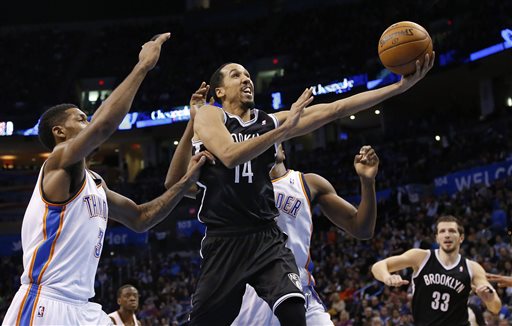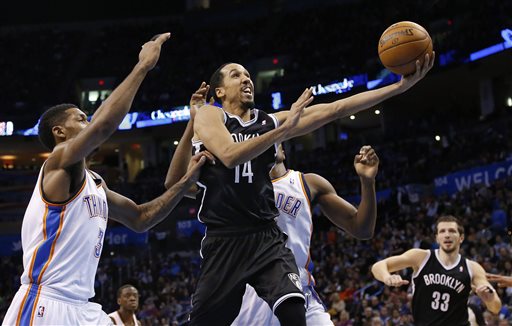
With the 7’2″ All-Star center Brook Lopez out for the season with a broken foot, Nets head coach Jason Kidd may have found his replacement in the starting lineup — 6’7″ point guard Shaun Livingston.
Wait, what?
With the team running out of options after Christmas, the Nets tried out a unique starting lineup last Friday night against the Milwaukee Bucks, putting point guards Deron Williams and Shaun Livingston together on the floor and moving Paul Pierce to the nominal “power forward” position. It wasn’t the first time Livingston and Williams shared the floor, but it was the first time the two started, and they played a season-high 13 minutes together.
It was in those minutes that the Nets first built their lead, one they’d never relinquish: they outscored the Bucks 29-16 with Williams & Livingston sharing the creative duties in two floor stretches. They jumped out to a 15-10 lead in the first 6:42 of play, and ran out on a 14-6 run in the first 6:04 of the third quarter.
“I thought it got us off to a good start,” Kidd said of the Williams-Livingston combo. “The ball was moving. We were getting great looks.”
Neither point guard turned the ball over with the other on the floor, and the Nets only lost one turnover with the two — a careless dribble bounce by Kevin Garnett on the very first possession of the game. Sure, Milwaukee’s a bad team, but they’re in the top half of the league in causing opponent turnovers, forcing a cough-up on 15.6 percent of possessions.
Garnett said the advantage came from having two players that can quickly divert the defense from their gameplan. “We knew they (Milwaukee) liked to do a half-court trap, and dictate pace, and when you got two of the best at handling the ball in there, it makes it difficult to do that.”
Milwaukee set up in a full-court press on a few possessions with Williams and Livingston in, but it proved completely ineffective — the Nets broke it with ease. The Bucks tried to get into a half-court trap, but the Nets often brought the ball up in the middle of the floor or got across the half-court mark too quickly for the Bucks to set up anything but a basic man or zone defense.
Okay, so Livingston isn’t a center. But his insertion into the lineup creates a few funky changes in the lineup: it moves Kevin Garnett back to center, where he’s played the majority of his last two seasons, moves Joe Johnson to small forward, which he basically is anyway, and moves Paul Pierce to power forward, a new challenge for the Hall of Fame forward who’s already dealt with a move to the bench.
Though Livingston doesn’t space the floor with three-point shots — he’s made just one this season in five tries — his passing ability and basketball IQ opens up the floor for teammates. In preseason, multiple teammates spoke at length about Livingston’s keen eye for finding teammates, going so far as to work individually with players to find out exactly where on their bodies they like catching the ball to shoot comfortably after the catch.
One way to think of it: on offense, Livingston is a revolutionary power forward (or center) with extraordinary passing and driving ability, while Johnson, Williams, and Pierce are the wings, spacing the floor around he and Garnett. (Same with Mirza Teletovic or Alan Anderson in the game for Pierce or Johnson.) On defense, Livingston is a shooting guard, quick enough to defend point guards and long enough to defend shooting guards, but not nearly strong enough to defend bigger players.
With a point guard at power forward, the Nets are less susceptible to turnovers, and when a team doesn’t turn the ball over, it gets shots — lots of them. With those two maintaining possession on the floor, it translated to 21 shots in 13 minutes against the Bucks, leading to 29 points and drawing five shooting fouls. “It’s a big advantage, especially if you have good shooters out there,” Mirza Teletovic said of the two-man combo, before adding “We had good spacing. Spacing is very important.”
Livingston said he feels comfortable playing alongside Williams.
“(We’re) two floor leaders out there that can help direct our offense, and give us a better flow,” Livingston said after the Bucks game last week. “I trust my IQ out there. I think Jason trusts my IQ. So it’s just putting myself in the right position to where I can help guys.”
Livingson is an instinctual player, and it allows him to make quick decisions with the ball to either get a shot for himself or find teammates open. Additionally, his 6’7″ frame, 6’11” wingspan, and incredibly high shot release allow him to shoot over the top of defenders with ease.
Kidd said he’d be intrigued to see it in their next game, Sunday against the Indiana Pacers, but did not play the combination for significant time again until they started against the 25-6 Oklahoma City Thunder in Oklahoma City Thursday night. Though Livingston struggled mightily, shooting just 1-7 from the field and committing four turnovers, Williams exploded for 29 points on 10-17 shooting and the duo was a +4 in 27 minutes together against the Thunder.
There are roadblocks. It’s very early, and Livingston’s erratic play with significant playing time means this might not be a long-term workable solution. With Pierce at the 4, that also means the Nets have a real disadvantage against teams that feature two post players. It’s likely not a lineup that the Nets will use night in and night out until the playoffs, especially since they’ll also need a point guard other than Tyshawn Taylor when both Livingston and Williams need to rest. But depending on the matchup, there’s certainly space here for the Nets to use the two alongside each other to create mismatches.















